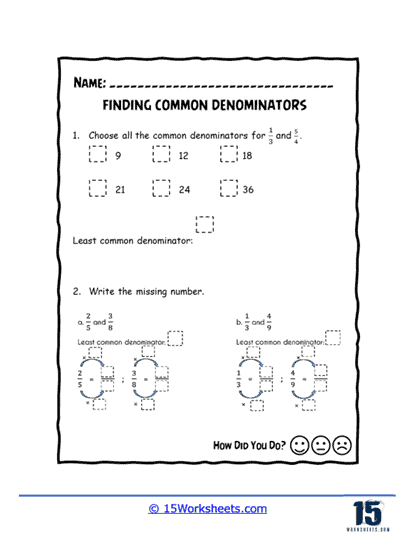

These Common Denominators worksheets are designed to help students master the concept of finding and using common denominators. Common denominators are essential in working with fractions, as they allow us to compare, add, and subtract fractions with different denominators.
Each worksheet in the series includes a variety of problems with varying levels of difficulty. The problems require students to find common denominators for pairs or groups of fractions, and to convert fractions with unlike denominators into equivalent fractions with common denominators.
These worksheets are designed to be both engaging and informative, with visual aids and detailed instructions. They also provide ample space for students to show their work and write down their answers, allowing them to develop their problem-solving skills and mental math abilities.
This series is most suitable for students in grades 4 to 7. It can be used in the classroom as a supplement to the math curriculum or at home as a way for parents to help their children practice and reinforce their math skills.
Overall, these Common Denominators worksheets are an engaging and effective tool for helping students develop their skills and confidence in finding and using common denominators. With these worksheets, students can build a strong foundation in fractions and math, which will serve them well in their future studies.
To find a common denominator for two or more fractions, follow these steps:
List the Multiples of Each Denominator
Write down the multiples of each denominator, starting with the denominator itself and increasing in value.
For example, if you have two fractions with denominators 3 and 5, list their multiples:
Identify the Least Common Multiple (LCM) of the Denominators
The LCM is the smallest number that is a multiple of each denominator. You can find the LCM by looking at the lists of multiples and finding the smallest number that appears in each list.
In our example, the least common multiple of 3 and 5 is 15 because it is the smallest number that appears in both lists of multiples.
Convert Each Fraction to an Equivalent Fraction with the Common Denominator
To do this, divide the LCM by the original denominator, then multiply both the numerator and the denominator of the fraction by the result.
For example, let’s say you have the fractions 2/3 and 3/5. To convert them to equivalent fractions with a common denominator of 15:
For 2/3, divide 15 by 3 to get 5. Multiply both the numerator and denominator of 2/3 by 5 to get 10/15.
For 3/5, divide 15 by 5 to get 3. Multiply both the numerator and denominator of 3/5 by 3 to get 9/15.
Now, you have the equivalent fractions 10/15 and 9/15 with a common denominator of 15. You can use these fractions to perform arithmetic operations like addition, subtraction, multiplication, or division.
How to Find Common Denominators For Mixed Numbers
To find common denominators for mixed numbers, you first need to convert the mixed numbers into improper fractions. Then, follow the same steps as you would for finding common denominators for fractions. Here’s a step-by-step guide:
Convert Mixed Numbers to Improper Fractions
To do this, multiply the whole number by the denominator and add the result to the numerator. The result will be the new numerator, while the denominator remains the same.
For example, let’s say you have mixed numbers 2 1/4 and 1 2/3.
List the Multiples of Each Denominator
Write down the multiples of each denominator, starting with the denominator itself and increasing in value.
Identify the Least Common Multiple (LCM) of the Denominators
The LCM is the smallest number that is a multiple of each denominator. In our example, the least common multiple of 4 and 3 is 12.
Convert Each Improper Fraction to an Equivalent Fraction with the common Denominator
Divide the LCM by the original denominator, then multiply both the numerator and the denominator of the fraction by the result.
Now, you have the equivalent improper fractions 27/12 and 20/12 with a common denominator of 12. You can use these fractions to perform arithmetic operations like addition, subtraction, multiplication, or division. If necessary, convert the resulting improper fraction back to a mixed number.